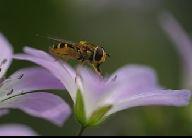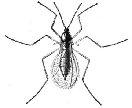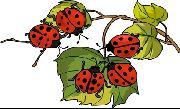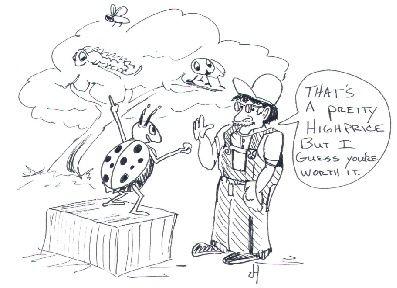Natural Solutions to Things That Bug You (80 page)
Read Natural Solutions to Things That Bug You Online
Authors: Myles Bader

HOVER FLIES (SYPHID FLIES)
General Information:
 These are very colorful flies that are yellow-striped and somewhat resemble bees or certain wasps. This weird appearance keeps them safe from birds; who tend to confuse them with bees. They are relatively harmless to humans and animals and can hang motionless in flight similar to a hummingbird. They prefer to feed on aphids, scale, thrips and leafhoppers. You may spot one on rose bushes that look like a tiny green worm.
These are very colorful flies that are yellow-striped and somewhat resemble bees or certain wasps. This weird appearance keeps them safe from birds; who tend to confuse them with bees. They are relatively harmless to humans and animals and can hang motionless in flight similar to a hummingbird. They prefer to feed on aphids, scale, thrips and leafhoppers. You may spot one on rose bushes that look like a tiny green worm.

They are attracted to yarrow, goldenrod, asters and Black-eyed Susan’s and will sip their nectar. Chances are if you plant these you will find that the flies will arrive if they are in the neighborhood. They will not sting you, however, they do resemble a wasp.
ROBBER FLY
General Information:
 These flies resemble bumblebees and can act very ferocious when attacking wasps and bees. They can be seen even chasing their prey when they are after small grasshoppers. Their larvae will feed on other larvae in the soil.
These flies resemble bumblebees and can act very ferocious when attacking wasps and bees. They can be seen even chasing their prey when they are after small grasshoppers. Their larvae will feed on other larvae in the soil.
TACHNID FLIES
General Information:
This bug looks like a large black housefly that needs a haircut.
They can also be found in yellow, red or brown and are usually seen around leaves and flowers. They attach their eggs to caterpillars or on the plants that they consume.
They do an excellent job of controlling the caterpillar population and especially European corn borers and gypsy moths. They prefer nectar or honeydew secreted by aphids and other insects.
There are over 1200 species in North America. The adult bugs like buckwheat and if you plant some you will have these flies in your garden.
FLY PARASITES
General Information:
 These are mainly livestock parasites that kill flies that frequent cattle and other livestock. People hardly ever even notice these flies. The fly parasites lay their eggs inside of fly pupae and kill them before they can ever emerge. They look for their prey around manure piles in stables, kennels, barns and feedlots. Commercial composting operations are one of their favorite hangouts.
These are mainly livestock parasites that kill flies that frequent cattle and other livestock. People hardly ever even notice these flies. The fly parasites lay their eggs inside of fly pupae and kill them before they can ever emerge. They look for their prey around manure piles in stables, kennels, barns and feedlots. Commercial composting operations are one of their favorite hangouts.
GREEN LACEWINGS
HERE, PRETTY BUG
General Information:
 The lacewing has long wings that look like a piece of old fashioned lace and very long antennae. They dine on aphids and their larvae as their favorite meal as well as other insect pests. They will be attracted to yarrow, Black-eyed Susan’s, goldenrod and the aster family.
The lacewing has long wings that look like a piece of old fashioned lace and very long antennae. They dine on aphids and their larvae as their favorite meal as well as other insect pests. They will be attracted to yarrow, Black-eyed Susan’s, goldenrod and the aster family.
The larva of the green lacewing also loves to feast on aphids and have been called
“aphid lions”.
The larva of the brown lacewing dines on aphids and also many soft-bodied insects such as the red spider mite, thrips, mealybugs, scale and will eat the eggs of many pest worms. The lacewing larvae, is very cannibalistic and if they are near each other eggs they will eat their own eggs.
They can be ordered and will arrive with the eggs packed in feeding material such as rice hulls. This is done in case some hatch while in transit and hopefully will eat the rice hulls instead of the other eggs. They are so minute that 1,000 of them would fit in a small thimble.
If you do see any movement you will need to disperse them immediately. Just sprinkle the eggs on the plant foliage, preferably on a warm day. If you want to keep them around they require some honey or sweet nectar.
BRRRRRRRRRRRRR
If you do buy lacewings don’t refrigerate them, just keep them at room temperature. Watch the bottom of the container in case some of the kids hatch and start looking for food.
LADYBUGS
Identification:
 These are round beetles that are about ¼+ inches long and are bright orange to red with a number of black spots and white markings on the thorax. They will consume about 400 aphids a day and an adult can eat thousands of aphids and scales during the season. The ladybug can produce 4-5 generations of offspring in one summer under ideal moisture conditions.
These are round beetles that are about ¼+ inches long and are bright orange to red with a number of black spots and white markings on the thorax. They will consume about 400 aphids a day and an adult can eat thousands of aphids and scales during the season. The ladybug can produce 4-5 generations of offspring in one summer under ideal moisture conditions.

General Information:
There are almost 400 species of ladybug worldwide. The
convergent lady beetle
is one of the best predators and their favorite meal is aphids but won’t turn down a good tasty meal of scales. They will also eat leafhoppers, thrips, and a variety of eggs and moths. In the late 1880’s one of the ladybugs relative the
Vedalia beetle
was imported from Australia and became famous for saving the California citrus crop from the cottony cushion scale.
LADYBUG, LADYBUG WERE HAVE YOU GONE
Ladybugs are a common insect that enjoys munching on aphids, mites, scales and whiteflies. They love daisies, tansy or yarrow and will frequent gardens that have these plants.
If you do purchase ladybugs there are a few important facts you should be aware of:
Make sure that the yard is well watered before releasing the ladybugs or they may fly away looking for a more, moist location. They must have water droplets to live.
Handle them very gently or they will get scared and fly away.
Be sure and place them at the base of the plants but don’t place too many in one location.
They can be stored in the refrigerator (not the freezer) for up to two weeks and released gradually.
Make sure you have food ready for them when you release them. Spray the plants with a 10% sugar or honey solution. You can also use a commercial food such as Control™, Honeydew™ or Wheast™.
If a plant has an aphid or scale infestation, place the ladybugs on the plant and cover the plant immediately.
Ladybugs: are easily killed by pesticides.
